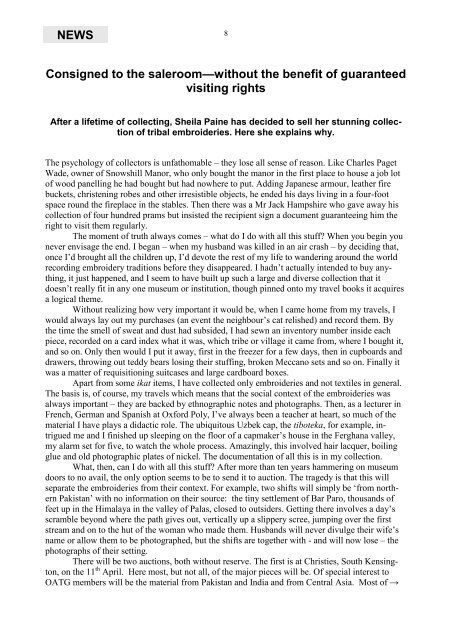Download - OATG. Oxford Asian Textile Group
Download - OATG. Oxford Asian Textile Group
Download - OATG. Oxford Asian Textile Group
Create successful ePaper yourself
Turn your PDF publications into a flip-book with our unique Google optimized e-Paper software.
NEWS<br />
8<br />
Consigned to the saleroom—without the benefit of guaranteed<br />
visiting rights<br />
After a lifetime of collecting, Sheila Paine has decided to sell her stunning collection<br />
of tribal embroideries. Here she explains why.<br />
The psychology of collectors is unfathomable – they lose all sense of reason. Like Charles Paget<br />
Wade, owner of Snowshill Manor, who only bought the manor in the first place to house a job lot<br />
of wood panelling he had bought but had nowhere to put. Adding Japanese armour, leather fire<br />
buckets, christening robes and other irresistible objects, he ended his days living in a four-foot<br />
space round the fireplace in the stables. Then there was a Mr Jack Hampshire who gave away his<br />
collection of four hundred prams but insisted the recipient sign a document guaranteeing him the<br />
right to visit them regularly.<br />
The moment of truth always comes – what do I do with all this stuff When you begin you<br />
never envisage the end. I began – when my husband was killed in an air crash – by deciding that,<br />
once I‘d brought all the children up, I‘d devote the rest of my life to wandering around the world<br />
recording embroidery traditions before they disappeared. I hadn‘t actually intended to buy anything,<br />
it just happened, and I seem to have built up such a large and diverse collection that it<br />
doesn‘t really fit in any one museum or institution, though pinned onto my travel books it acquires<br />
a logical theme.<br />
Without realizing how very important it would be, when I came home from my travels, I<br />
would always lay out my purchases (an event the neighbour‘s cat relished) and record them. By<br />
the time the smell of sweat and dust had subsided, I had sewn an inventory number inside each<br />
piece, recorded on a card index what it was, which tribe or village it came from, where I bought it,<br />
and so on. Only then would I put it away, first in the freezer for a few days, then in cupboards and<br />
drawers, throwing out teddy bears losing their stuffing, broken Meccano sets and so on. Finally it<br />
was a matter of requisitioning suitcases and large cardboard boxes.<br />
Apart from some ikat items, I have collected only embroideries and not textiles in general.<br />
The basis is, of course, my travels which means that the social context of the embroideries was<br />
always important – they are backed by ethnographic notes and photographs. Then, as a lecturer in<br />
French, German and Spanish at <strong>Oxford</strong> Poly, I‘ve always been a teacher at heart, so much of the<br />
material I have plays a didactic role. The ubiquitous Uzbek cap, the tiboteka, for example, intrigued<br />
me and I finished up sleeping on the floor of a capmaker‘s house in the Ferghana valley,<br />
my alarm set for five, to watch the whole process. Amazingly, this involved hair lacquer, boiling<br />
glue and old photographic plates of nickel. The documentation of all this is in my collection.<br />
What, then, can I do with all this stuff After more than ten years hammering on museum<br />
doors to no avail, the only option seems to be to send it to auction. The tragedy is that this will<br />
separate the embroideries from their context. For example, two shifts will simply be ‗from northern<br />
Pakistan‘ with no information on their source: the tiny settlement of Bar Paro, thousands of<br />
feet up in the Himalaya in the valley of Palas, closed to outsiders. Getting there involves a day‘s<br />
scramble beyond where the path gives out, vertically up a slippery scree, jumping over the first<br />
stream and on to the hut of the woman who made them. Husbands will never divulge their wife‘s<br />
name or allow them to be photographed, but the shifts are together with - and will now lose – the<br />
photographs of their setting.<br />
There will be two auctions, both without reserve. The first is at Christies, South Kensington,<br />
on the 11 th April. Here most, but not all, of the major pieces will be. Of special interest to<br />
<strong>OATG</strong> members will be the material from Pakistan and India and from Central Asia. Most of →

















